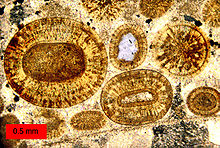Ooid

Ooids ( Gr . Oon "egg") are spherical-oval to pea-sized mineral bodies that are formed from concentric growth shells or radially- fibrous around a mostly different core. Ooids can consist of various minerals , the most common being lime ooids. Similar particles with a larger diameter are the pisoids .
Oolites are sedimentary rocks and consist of ooids that are cemented with a binding agent . They are named differently, depending on the mineral from which the ooids are mainly composed ( Rogenstein , Erbsenstein , Eisenoolith, Kieseloolith).
education
Two prerequisites are necessary for ooids to form. On the one hand, there must be a high concentration of calcium carbonate in the water ( oversaturated solution ), and on the other hand, the water must be kept moving so that the ooids that are formed maintain their round shape. Therefore, lagoons in which there are slight waves are formation spaces for ooids.
If the two conditions described above are met, a crystallization nucleus , for example a grain of sand, is a prerequisite for the formation of an ooid. Layers of lime or iron now begin to separate from the water around this germ. This process continues until the body becomes too heavy and sinks to the bottom. This is why ooids are almost the same size. The nuclei of crystals can still be seen in some ooids.
Iron oids
Eisenooids are ooids made from limonite (brown iron stone) or hematite (red iron stone ). These also form in the sea and represent iron hydroxide precipitates that attach to kaolinite platelets.
literature
- Maurice E. Tucker: Introduction to Sedimentary Petrology . Enke, Stuttgart 1985, ISBN 3-432-94781-X .

